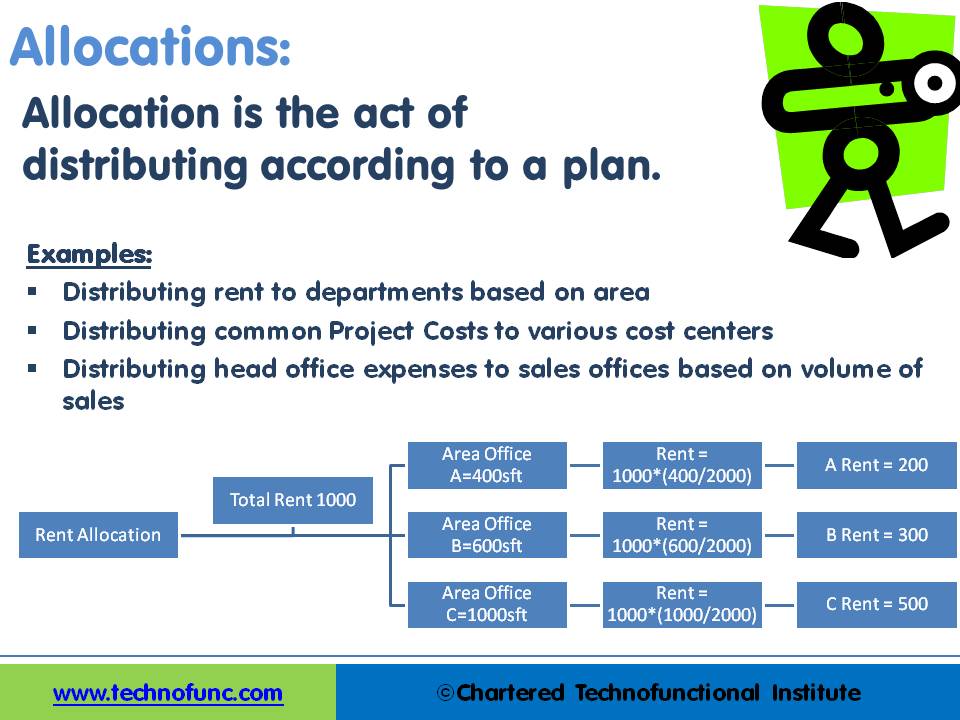- Home
- Business Processes
- Industry Knowledge
- Aerospace Industry
- Automotive Industry
- Banking Domain
- BFSI Industry
- Consumer/ FMCG Industry
- Chemicals Industry
- Engineering & Construction
- Energy Industry
- Education Domain
- Finance Domain
- Hospitality Domain
- Healthcare Industry
- Insurance Domain
- Retail Industry
- Travel and Tourism Domain
- Telecom Industry
- Leadership Skills
- eLearning
- Home
- Domain Knowledge
- General Ledger
- GL - Account Allocations
GL - Account Allocations
An allocation is a process of shifting overhead costs to cost objects, using a rational basis of allotment. Understand what is the meaning of allocation in the accounting context and how defining mass allocations simplifies the process of allocating overheads to various accounting segments. Explore types of allocations and see some practical examples of mass allocations in real business situations.
What is Account Allocation?
Allocation is the act of distributing according to a plan. As per the dictionary allocate means to set apart for a special purpose; designate; distribute according to a plan. From an accounting context, it means a system of dividing overhead expenses between the various departments of a business. Figuratively, earmarked is often used in regard to monetary allocations although it is heard in other contexts as well.
The allocation also refers to a piece of the pie, a share in the profits, a portion of whatever is being divided up and parceled out usually money, but in an accounting context is applicable to account balances. This expression probably has its origin in the graphic representation of budget allotments in circular, pie-shaped form, with various sized wedges or pieces indicating the relative size of allocations to different agencies, departments, etc.
Concept of Mass Allocations:
Mass allocations is a functionality offered by many automated systems and ERPs to distribute the account balances from one account to several others based on a formula or mathematic logic. Users can define a Mass Allocation formula to create journals that allocate revenues and expenses across a group of cost centers, departments, divisions, locations, and so on using any accounting dimension available. Users can include parent values in allocation formulas that can enable allocating to the child values referenced by the parent without having to enumerate each child separately.

Different Type of Allocations:
The commonly used allocations can be grouped as follows:
- Net Allocations: allocated amounts that reflect changes to the cost pool.
- Step–Down Allocations: distributing amounts from one allocation pool to a subsidiary allocation pool.
- Rate-Based Allocations: using current, historical, or estimated rates to allocate costs.
- Usage-Based Allocations: using statistics such as headcount, units sold, square footage, number of deliveries, or computer time consumed to calculate allocation amounts.
- Standard Costing Allocations: using statistics such as sales units, production units, number of deliveries or customers served to perform standard costing.
Examples of Allocation:
Allocations can be used in various practical business situations. For example, consolidated rent paid can be allocated to another division based on the area of usage, or, a pool of marketing costs can be allocated to several departments based on the ratio of department revenues to total revenues. Some of the commonly used examples are:
- Distributing rent to departments based on area
- Distributing common project costs to various cost centers
- Distributing head office expenses to sales offices based on the volume of sales
- Distributing marketing costs to product lines based on revenue
- Distributing common employee expenses to employee cost for assessments
In the example shown in the figure, we have a company which has taken a 1000 square feet office space on rent. The expenses for rent are borne by the head-office and payment to the landlord is also made by the head office. To know the true profitability of each of the departments (Department A, B & C) the rent needs to be allocated to each one of them.
Each department occupies different areas and the company has taken the measurement of the areas occupied by each of the departments. In the example shown here, the rent is being allocated to different departments based on their usage factor. This is an example of the concept of allocation and automated accounting systems help handle complex allocations programmatically.
Difference between Allocations & Recurring Journals:
Recurring Journals are for transactions that repeat every accounting period and allocation Journals are for single journal entry using an accounting or mathematical formula to allocate revenues and expenses across a group of accounting dimensions like cost centers, departments, divisions, locations, or product lines depending upon usage factors.
Related Links
You May Also Like
-
Multitude of these legal and operational structures clubbed with accounting and reporting needs give rise to many reporting dimensions at which the organization may want to track or report its operational metrics and financial results. This is where business dimensions play a vital role.
-
Introduction to Organizational Structures
Organizations are systems of some interacting components. Levitt (1965) sets out a basic framework for understanding organizations. This framework emphasizes four major internal components such as: task, people, technology, and structure. The task of the organization is its mission, purpose or goal for existence. The people are the human resources of the organization.
-
Legal Structures for Multinational Companies
A multinational company generally has offices and/or factories in different countries and a centralized head office where they coordinate global management. A multinational company (MNC)is a corporate organization that owns or controls the production of goods or services in at least one country other than its home country.
-
Although technically a general ledger appears to be fairly simple compared to other processes, in large organizations, the general ledger has to provide many functionalities and it becomes considerably large and complex. Modern business organizations are complex, run multiple products and service lines, leveraging a large number of registered legal entities, and have varied reporting needs.
-
In every journal entry that is recorded, the debits and credits must be equal to ensure that the accounting equation is matched. In this article, we will focus on how to analyze and recorded transactional accounting information by applying the rule of credit and debit. We will also focus on some efficient methods of recording and analyzing transactions.
-
What Is a General Ledger? General Ledger (also known in accounting as the GL or the Nominal Ledger) is at the heart of any accounting system. A general ledger is the master set of accounts that summarize all transactions occurring within an entity. Ledger is the skillful grouping and presentation of the Journal entries. Learn the accounting fundamentals, general ledger process, and general ledger flow.
-
After reading this article the learner should be able to understand the meaning of intercompany and different types of intercompany transactions that can occur. Understand why intercompany transactions are addressed when preparing consolidated financial statements, differentiate between upstream and downstream intercompany transactions, and understand the concept of intercompany reconciliations.
-
A subsidiary is a company that is completely or partly owned by another corporation that owns more than half of the subsidiary's stock, and which normally acts as a holding corporation which at least partly or wholly controls the activities and policies of the daughter corporation.
-
GL - Unearned / Deferred Revenue
Unearned revenue is a liability to the entity until the revenue is earned. Learn the concept of unearned revenue, also known as deferred revenue. Gain an understanding of business scenarios in which organizations need to park their receipts as unearned. Look at some real-life examples and understand the accounting treatment for unearned revenue. Finally, look at how the concept is treated in the ERPs or automated systems.
-
In most of the automated financial systems, you can define more than 12 accounting periods in a financial year. This article will explain the concept of the adjustment period and the benefits of having adjustment periods. Adjustment periods have their inherent challenges for the users of financial statements and there is a workaround for those who don’t want to use adjustment periods.
Explore Our Free Training Articles or
Sign Up to Start With Our eLearning Courses

About Us
Learning
© 2023 TechnoFunc, All Rights Reserved









